Published Dec 7, 2023
The 8 Nights of Star Trek
The Kaplans reflect on their annual tradition of revisiting Star Trek films on each night of Hanukkah.
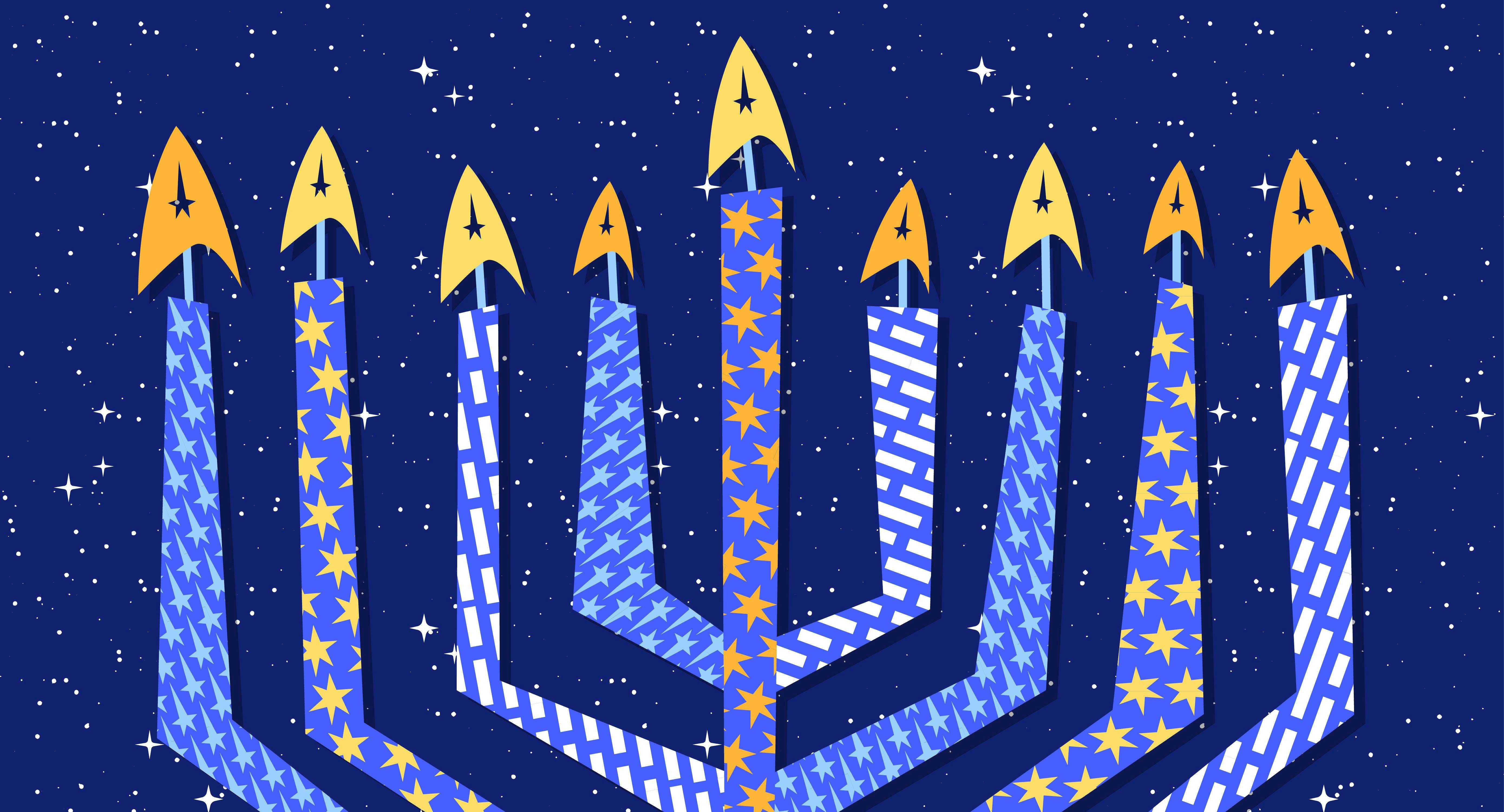
StarTrek.com / Rob DeHart
In the Nexus, it’s always Christmas!
Lt. Shax, Star Trek: Lower Decks
In the Kaplans’ Quarters, it has become an annual tradition to revisit the first eight Star Trek movies after we’ve lit the menorah on each of the eight nights of Hanukkah. While the majority of the films don’t make reference to any of Earth’s December holidays, they nevertheless make sense for our season viewing festivities — both individually and as a collective arc. Besides, because shooting on the original Star Trek pilot began on December 12, 1964, December is an ideal time to celebrate the Franchise.
Enter, friend, and let us share some of the Trekmas traditions we’ve established (so far)!
1.
Star Trek: The Motion Picture is an ideal starting point because of the movie’s thoughtful use of light. Naturally, all motion pictures (like holograms) are, by definition, comprised of light. However, light plays an especially important role in TMP.
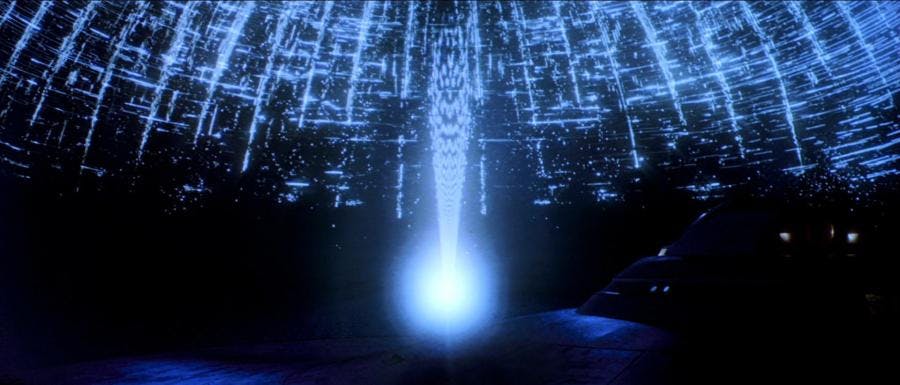
Star Trek: The Motion Picture
StarTrek.com
This begins with the movie’s overture, in which director Robert Wise begins the festivities with several minutes of Jerry Goldsmith’s score – in complete darkness. As Kirk and Spock are reunited with the rest of the Enterprise crew, light continues to play an integral part — V’ger is encased in an energy field, the Enterprise is invaded by a probe made of light, and several shots concern the ship flying through multicolored wormholes and glowing energy passages.
In the Northern Hemisphere, the December holidays occur during the time of the year when the nights are the longest. In general, this prolonged darkness, and the associated effect on human psychology, might help explain why so many winter holidays are associated with candles, illuminated trees, and other seasonal lights.
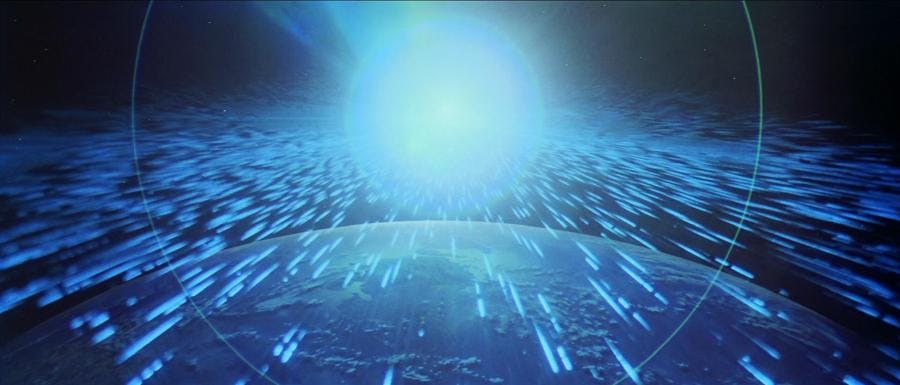
Star Trek: The Motion Picture
StarTrek.com
In Judaism, Hanukkah is commonly referred to as the Festival of Lights, or chag ha-ooreem in Hebrew. The origins of the term date back to the Antiquities of the Jews by Josephus Flavius (born AD 37/38 — died AD100), a Jewish priest and historian, in which he "speculates that the name comes from the fact that the right to worship and sacrifice again in the ancient temple was 'brought to light.'" This, of course, bears no resemblance to the myth told by modern Jews about the miracle of the tiny jar of oil lasting for eight days, which is invoked as an explanation for the reason behind the lighting of a menorah candle for each night.
2.
For those who had family or religious holiday traditions forced upon them as a child, the celebration of anything resembling a seasonal winter celebration can seem anathema. In other words, it can be easy to become like Khan, hardened in opposition to what you have defined yourself against. While it may be necessary to reject certain holiday elements for your own survival, there’s a difference between surviving a living.
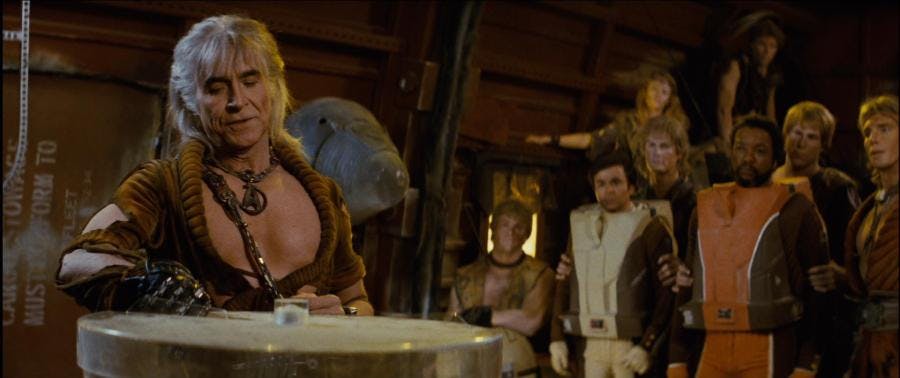
Star Trek II: The Wrath of Khan
StarTrek.com
This complicated interplay between outright opposition as compared with acceptance and integration of certain elements of tradition is a theme that has been addressed time and again throughout the history of the Star Trek franchise. A contemporary example can be found in the episode "Ghost in the Machine," in which a hologram version of The Diviner observes that Gwyn must find her own way in spite of her fathers’ intentions.
Plus, being encouraged to question certain aspects of belief in Judaism ensures that, unlike Khan, you don’t end up feeling locked out of your own life. We like to remember the importance of questioning belief and dogma on both the second and fifth of our Eight Nights of Star Trek.
3.
The Search for Spock marks the final voyage of the original Enterprise. As such, this is the perfect time to mention our beloved Trekmas Tree topper – the Enterprise, as it appeared in the classic episode of , “.”
If you’re reading this article, you’re most likely already aware of the Hallmark Legacy “Mirror, Mirror” collection. Not only were the Enterprise and the first ornaments released in 2020, but the impressive light, sound, and music show that results when all seven crew members are connected has made the set a mainstay on social media.
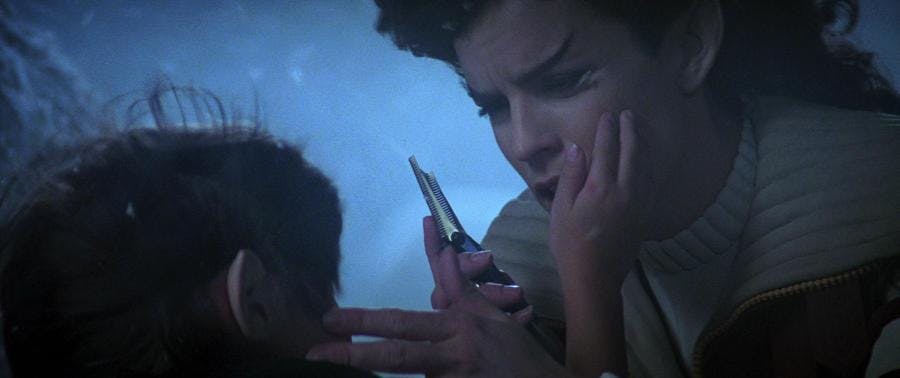
Star Trek III: The Search for Spock
StarTrek.com
The Search for Spock is also the first of two Star Trek movies directed by Leonard Nimoy, who brought his Jewish heritage to the franchise, especially through Spock and his contributions to the Vulcan culture. For one thing, the Vulcan salute, associated with “Live Long and Prosper,” is . Kohanim is the Hebrew word for “priest,” used in reference to direct descendants of Aaron, brother of Moses. This fact is of special importance in the Kaplans’ Quarters, as the Kaplan line is Kohanim.
4.
In The Voyage Home, the resurrected Spock comes to terms with the balance between his human and Vulcan heritage. In this synthesis, the culmination of a major subplot for the first four movies, we see a reflection of our personal Trekmas traditions. By blending holiday rites most often associated with Christmas and Hanukkah, we have created our own annual celebration that possesses personal meaning.
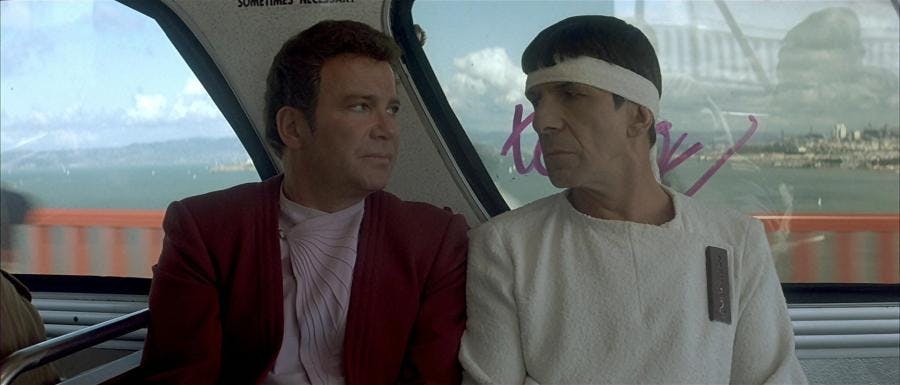
Star Trek IV: The Voyage Home
StarTrek.com
This was the final Star Trek film to be directed by Nimoy, and at the heart of the story is the deep friendship between Kirk and Spock, who become reacquainted with one another on the streets of 1980s San Francisco after Spock’s visit to The Black Mountain over the course of the previous two movies.
Perhaps part of the reason the friendship between the two characters speaks so deeply to us fans is that it also reflects the relationship behind the camera. In the memoir Leonard: My Fifty-Year Friendship with a Remarkable Man, Shatner discusses how his friendship with Leonard was built on a shared heritage that included being raised in Orthodox Jewish immigrant families. Shatner writes, “Our lives were shaped by the same historical hatreds and the courage and desire of our families – Jews who fled Eastern Europe to escape persecution.”
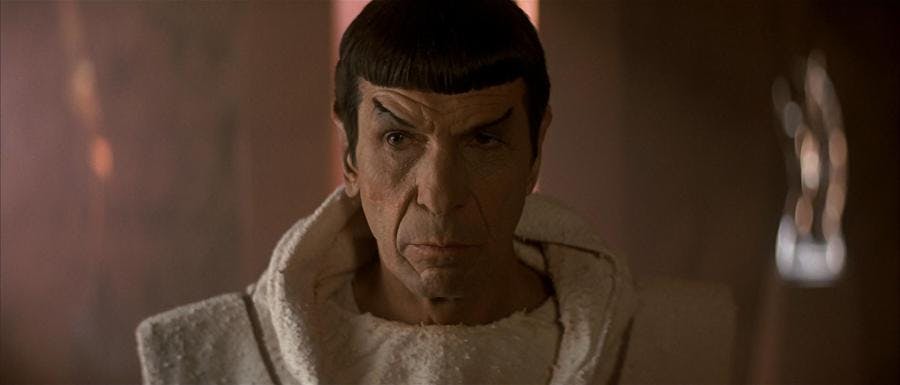
Star Trek IV: The Voyage Home
StarTrek.com
Meanwhile, in his memoir I Am Spock, Nimoy remembered their friendship much differently. "I think it’s time the world knew the hidden, ugly truth about what really was happening on the Star Trek set," wrote Nimoy. "Bill Shatner is one of the worst punsters in the world, and it soon became his 'five-year mission' to try to crack me up on set."
5.
Directed by Shatner, The Final Frontier reminds us how important music is to the Star Trek franchise and for the holiday season. In addition to the memorable rounds of “Row, Row, Row Your Boat,” — and who doesn’t love singing together during the holiday season — this movie also features the return of Goldsmith as composer, including the recurrence of the theme from TMP (which was also the basis for The Next Generation’s theme song).
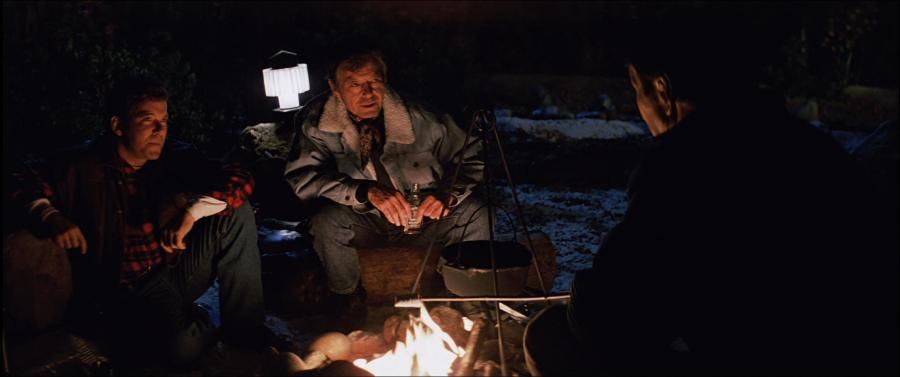
Star Trek V: The Final Frontier
StarTrek.com
Meanwhile, Kirk’s climactic question — the unforgettable theistic inquiry “What would g-d need with a starship?” — reminds us that being part of a community doesn’t mean accepting everything shoveled upon us without exercising our analytical skills. In particular, Kirk being bold enough to raise his finger and ask the question of an entity claiming to be a deity shows how brave you have to be to interrogate dogma that everyone around you has accepted.
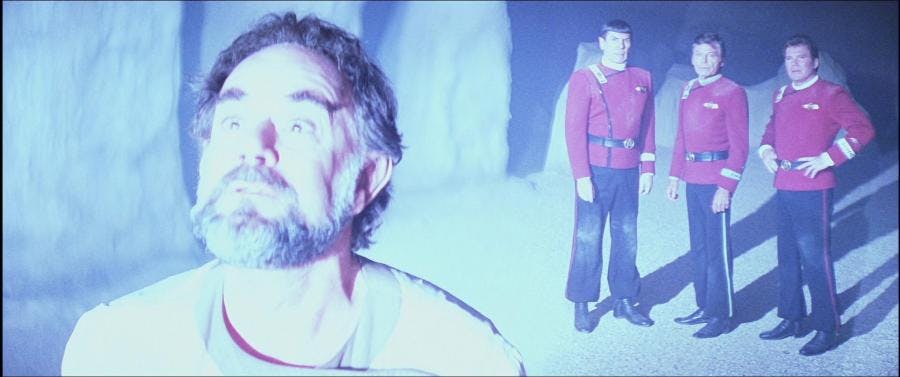
Star Trek V: The Final Frontier
StarTrek.com
Naturally, this wasn’t the only time Kirk refused to bow down before an entity claiming to be a god — the TOS episode “” and the episode of featuring Kukulkan, “How Sharper Than a Serpent’s Truth,” being just two examples. However, it can be particularly difficult to stand up to this kind of pressure when it's coming from a family member… And Sybok is basically Kirk’s brother by extension, right?
6.
What better movie to consider the importance of sharing meals during the holiday season than The Undiscovered Country? The backbone of our Hanukkah menu are latkes. However, as delicious as the oil-fried potato-and-onion pancakes may be, until the food replicator is invented, making them is labor-intensive and time-consuming.
Fortunately, that’s where cooking with Neelix comes in! As Voyager’s morale officer knew, food is important to celebrating and building community, especially during the Festival of Lights. Enter the Star Trek Cookbook by Ethan Phillips and William J. Birnes. Not only is this hefty tome filled with tasty recipes from throughout the Star Trek universe, but it also features commentary by Neelix himself and guest contributions from many legacy actors.
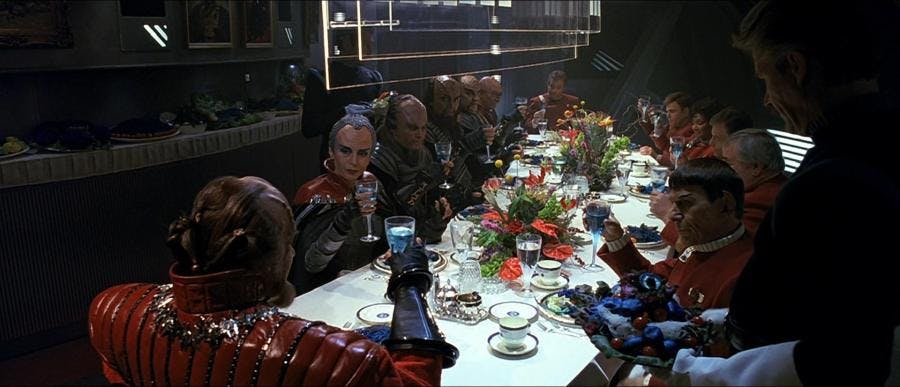
Star Trek VI: The Undiscovered Country
StarTrek.com
Naturally, we find the “original Klingon” recipes most appropriate for The Undiscovered Country’s show-stopping dinner scene. But looking forward to summer grilling celebration plans, be sure and bookmark the BBQ marinade Jonathan Frakes stole from Alfre Woodard. It tastes great on chicken!
7.
Resisting assimilation is futile. If you have Jewish friends or grew up in a Jewish household, you likely already know people who have sought to meld the Christmas and Hanukkah traditions. And there is a long history of how Jews have chosen to incorporate the Christian holiday into their identities, especially as Christmas in America began to change from a religious to a secular-capitalist holiday. Here in the Kaplan’s Quarters, where we have Russian-Jewish heritage, we have also chosen to incorporate things like the Yolka Tree.
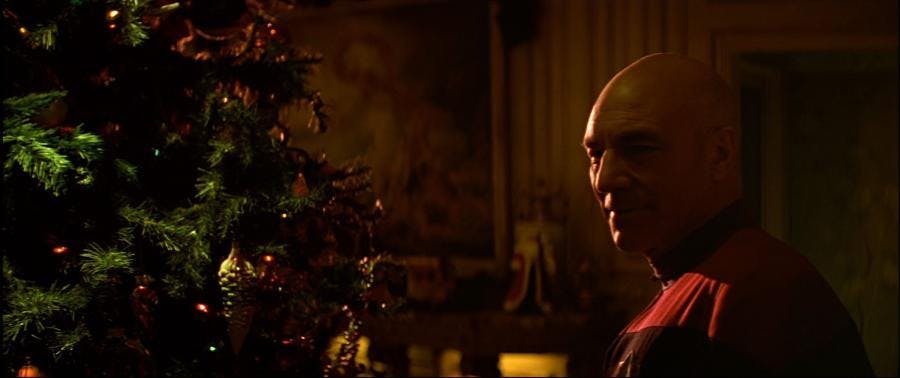
Star Trek Generations
StarTrek.com
In Generations, two generations are brought together through the Nexus where it’s always Christmastime. What could be more festive? The fact that Jean-Luc Picard realizes he’s inside the Nexus, because of the ornaments on the decorated trees, means this is the opportune moment to bring up the rest of the decorations on our Trekmas Tree.
Since 1991, Hallmark has released at least one Star Trek ornament per year, with every series but Lower Decks and Prodigy represented (although, you can pretend with the Delta Flyer and Galileo shuttlecraft). While our collection is far from complete (and limited by our supply of Latium), the ornaments enjoy a robust second market that ensures years of holiday hunting to come.

Star Trek Generations
StarTrek.com
Generations is also the first time the Holodeck appears on the big screen in the Star Trek universe in a memorable scene in which Worf is promoted “at sea” on a historic Enterprise. Since holograms are comprised of light, any Holodeck scene or episode is appropriate for the Festival of Lights, no? Generations pairs well with' ""!
8.
In the opening scenes of TMP, Spock fails to complete the Vulcan rite of Kolinahr; instead being called to space by a signal that we eventually learn has origins on Earth. At the conclusion of the eighth movie, First Contact, Vulcans make First Contact with humans. This event serves as the catalyst for an unprecedented period of peace and prosperity for Earth.
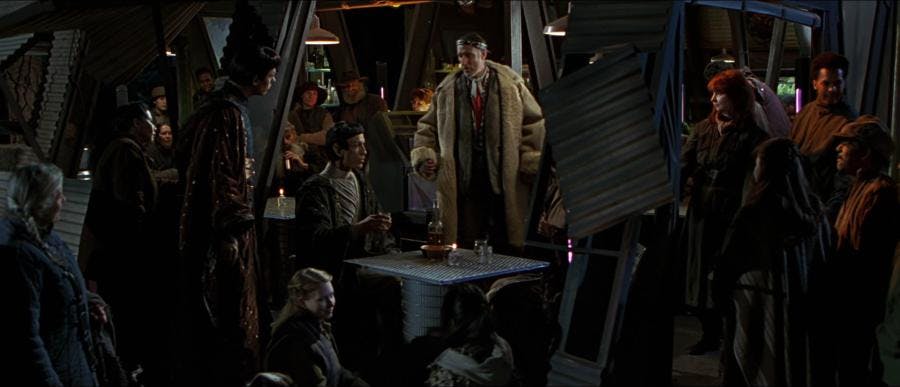
Star Trek: First Contact
StarTrek.com
While First Contact is the first movie to exclusively feature Captain Picard’s crew (now aboard an Enterprise so fresh it still has that new carpet smell), it does feature one key cyclical element. The music is once again composed by Goldsmith, whose overture for TMP began this eight-movie cycle. And keeping with the family theme, he completed the First Contact score with assistance from his son Joel, who composed 22 minutes of music.
The movie also marks the second occurrence of Moby Dick in the Star Trek movies. Originally read and quoted by Khan, its appearance in First Contact represents Picard’s post-Locutus fixation with the Borg. However, unlike Khan, Picard can move beyond this obsession (a personal journey that has continued to develop on Star Trek: Picard). Concluding our seasonal eight-movie arc with this movie helps remind us that an important theme throughout Star Trek is to always strive to connect rather than build walls… and that this may be a very long process, but a worthwhile one.
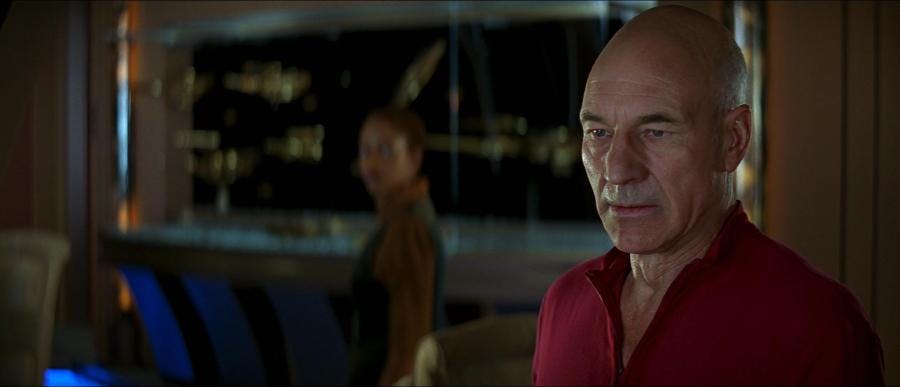
Star Trek: First Contact
StarTrek.com
Although First Contact is set in April, which is when the traditional “First Contact Day Salmon” would be served, here in the Kaplan’s Quarters, we celebrate our eighth night of Star Trek in a manner that also commemorates our shared status as West Coast children of New York DNA donors — bagels, lox, and schmear.
How do you and your crew celebrate the Trekmas season?





